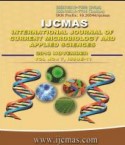


 National Academy of Agricultural Sciences (NAAS)
National Academy of Agricultural Sciences (NAAS)

|
PRINT ISSN : 2319-7692
Online ISSN : 2319-7706 Issues : 12 per year Publisher : Excellent Publishers Email : editorijcmas@gmail.com / submit@ijcmas.com Editor-in-chief: Dr.M.Prakash Index Copernicus ICV 2018: 95.39 NAAS RATING 2020: 5.38 |
An efficient protocol was developed for commercial multiplication of gerbera using young capitulum as explant across different varieties of gerbera. Media for culture establishment, shoot regeneration, multiplication were standardized. Mercuric chloride treatment (0.1%) for 2 minutes was found to be the best surface sterilant for capitulum explants resulting in the minimum per cent contaminated growing cultures (17.27%). For regeneration MS medium supplemented with 3mg/l BAP + 0.3mg/l NAA was found good. The capitulum of six gerbera varieties viz., Arka Krishika, Arka Nesara, Arka Ashwa, Basics, Morelia and Stanza were utilized. Regeneration from capitulum explants was achieved through direct organogenesis and cultures regenerated were multiplied up to five subculture cycles. The variety Arka Ashwa recorded the highest shoot regeneration percentage (70.0%) followed by Arka Nesara (51.25%). The number of segments regenerated was high in the Arka Ashwa (28.00) followed by Arka Nesara (20.50) and stanza (20.25). By repeated subculturing of the capitulum explant a high frequency of shoot multiplication was established in MS medium supplemented with 3mg/l BAP + 0.3mg/l NAA Arka Nesara recorded highest proliferation (2.3) rate in the 1st subculture followed by Arka Ashwa (2.28). Shoot multiplication was found very low in variety Morelia (1.2). Same trend was observed from 2nd subculture to 5th subculture. The described protocol seems to be technologically suitable for clonal multiplication of gerbera on a large scale, encompassing high genetic and quality propagation material. Within the short span a well acclimatized plants were obtained from a single initial capitulum explant, clearly revealing the potentiality of such technological strategy to overcome the lack of true-to-type propagation material.
 |
 |
 |
 |
 |